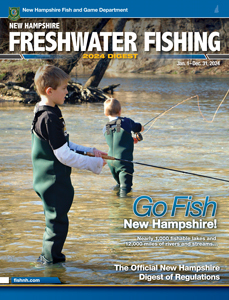Stop Aquatic Hitchhikers!
The quality of our waters is extremely valuable, both as a natural and economic resource. In addition to providing essential aquatic habitat, New Hampshire’s waters annually provide 14.7 million visitor days for boating, fishing and swimming — popular family-oriented recreational activities that add more than $1 billion to the state’s economy each year. Your help is needed to protect these resources. It’s up to boaters and anglers to keep nuisance species from invading New Hampshire’s waters!
New Hampshire’s waters are threatened by several non-native aquatic invasive plants and animals. They can easily be transported to new waters by boats, motors, trailers, fishing equipment, live-wells, bait buckets, diving gear and other aquatic recreational equipment. Check your boat and equipment and remove any plants or other materials—milfoil and other invasives can easily adhere to propellers and many other catch points.
Invasives can also be put into our waters by individuals who are not aware of the environmental and economic damages these nuisance plants and animals can cause. Never release plants, fish or animals into a body of water unless they came out of that body of water. It’s the law!
Invasive Plants
RSA 487: 16-c states it is illegal to transport, import, purchase, propagate, sell, or distribute 14 species of non-native aquatic plants in New Hampshire. Among the 14 species, variable milfoil is the most abundant and problematic invasive aquatic plant in New Hampshire.
Invasive Animals
Nonnative invasive animals are also a growing concern in New Hampshire. Zebra mussels and quagga mussels can attach to boat hulls and clog water intake systems. They are not here yet—it is extremely important to keep them out of New Hampshire waters.
Asian clams are already present in the lower Merrimack River and several ponds; they compete with native mussels for space and food.
The Chinese mystery snail is also here, present in lakes and ponds as far north as the Lakes Region. Rusty crayfish have been found in Vermont. The spiny water flea and the fishhook water flea are present in the Great Lakes and Lake Champlain. These invaders compete with native species for zooplankton, affecting the entire food chain.

It’s the Law
RSA 487:16-d requires boaters to drain their boat and other equipment that holds water, including live wells and bilges, when leaving a waterbody. Pursuant to RSA 487:43, a special aquatic invasive species out of state boater decal is required for display on motorized boats registered in a state other than New Hampshire, which are used on New Hampshire’s waters. The out-of-state boater decal is available at www.des.nh.gov.
Learn More
For more information, contact the NH Department of Environmental Services, Exotic Species Program at 603-271-2248, des.nh.gov; NH Fish and Game at 603-271-2501, fishnh.com; or visit protectyourwaters.net.


